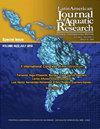罗非鱼后院养殖系统评价的生物经济模型
IF 0.8
4区 农林科学
Q3 FISHERIES
Latin American Journal of Aquatic Research
Pub Date : 2023-04-30
DOI:10.3856/vol51-issue2-fulltext-2999
引用次数: 0
摘要
后院水产养殖作为墨西哥农村家庭的食物和经济投入来源,越来越重要。该系统的盈利能力有待确定。生物经济工具允许对任何生产系统进行利润预测。考虑到某些环境条件下的理论生产参数,开发了一个由生物、生产和经济子模型组成的生物经济模型,以评估适合农村社区的低成本后院水产养殖系统(BAS)。BAS由一个2800升的蓄水池组成,蓄水池中储存着168只雄性化的1克罗非鱼(Oreochromis niloticus)鱼种,密度为60 ind m-3,并用两台0.046马力的冒险型潜水泵充气,每台泵的流量为1400升h-1。分析了两个培养周期,每个周期25周。初始投资为1200美元(775美元的设备+425美元的运营成本,每年1次)。该模型的结果表明,考虑到10%的死亡率,303条鱼的产量为614克,相当于186公斤yr-1。以3.62美元kg-1的价格出售,净利润从184美元到16美元不等,分别为0和25%的自我消费。在0和10%的自耗情况下,回收期分别为三年和四年,但在25%的情况下,超过了五年。在不同的自我消费百分比、销售价格和温度下,构建了盈利指标(成本效益、净现值和内部回报率)的响应面图。总之,BAS是墨西哥和其他拉丁美洲国家农村地区低规模生产罗非鱼的一种可行的自我可持续的替代品。本文章由计算机程序翻译,如有差异,请以英文原文为准。
Bioeconomic model for the evaluation of a backyard aquaculture system for tilapia (Oreochromis niloticus)
Backyard aquaculture is gaining importance as a source of food and economic input for rural families in Mexico. The profitability of this system needs to be determined. Bioeconomic tools allow for making profit projections of any production system. A bioeconomic model composed of biological, production, and economic sub-models was developed to evaluate a low-cost backyard aquaculture system (BAS) appropriate for rural communities, considering theoretical productive parameters at certain environmental conditions. The BAS consisted of a 2800 L water reservoir stocked with 168 masculinized 1 g fingerlings of tilapia (Oreochromis niloticus) at 60 ind m-3 density and aerated with two ventury-type submerged pumps of 0.046 hp at a rate of 1400 L h-1 each. Two culture cycles of 25 weeks each were analysed. The initial investment was USD 1200 (USD 775 equipment + USD 425 operation cost yr-1). Results from the model indicate the production of 303 fishes of 614 g, equivalent to 186 kg yr-1, considering 10% mortality. Selling at USD 3.62 kg-1, net profits varied from USD 184 to 16 at 0 and 25% self-consumption. The payback period was three and four years at 0 and 10% self-consumption but was longer than five years at 25%. A response surface plot of profitability indicators (cost-benefit, net present value, and internal rate of return) was constructed at different self-consumption percentages, sale prices, and temperatures. In conclusion, BAS is a viable self-sustainable alternative for tilapia production at a low scale in rural areas of Mexico and other Latin American countries.
求助全文
通过发布文献求助,成功后即可免费获取论文全文。
去求助
来源期刊

Latin American Journal of Aquatic Research
FISHERIES-MARINE & FRESHWATER BIOLOGY
CiteScore
1.70
自引率
10.00%
发文量
44
审稿时长
4-8 weeks
期刊介绍:
Latin American Journal of Aquatic Research- LAJAR is the continuation of the journal Investigaciones Marinas (1970-2007) and is published since 2008 by the Escuela de Ciencias del Mar, Facultad de Ciencias del Mar y Geografía of the Pontificia Universidad Católica de Valparaíso. LAJAR is an “Open Access” journal that publishes in English language, original research articles, reviews and short communications on aquatic science, which contain the results of research conducted in aquaculture or in oceanic and coastal marine waters of Latin America.
The following topics are considered: Physical Oceanography, Chemical Oceanography, Marine Biogeochemistry, Marine Pollution and Toxicology, Marine Geology and Geophysics, Biological Oceanography, Fisheries and Aquaculture.
 求助内容:
求助内容: 应助结果提醒方式:
应助结果提醒方式:


